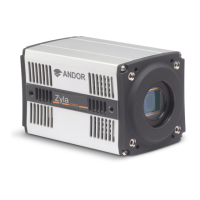version 2.0 rev 18 Feb 2021
30
2.6.2 Rolling Shutter Triggering Modes
In Rolling Shutter, charge transfer happens on a per row basis:
1. The node is reset,
2. A ‘reference’ measurement taken, and then the charge transferred,
3. The ‘signal’ is measured,
4. The reference and signal measurements are then subtracted in the analog domain.
5. Each following row is processed until the whole sensor is read out.
The disadvantage of this is that the start and end exposure time moves by the row read out time for each
subsequent row. So whilst each row of pixels is exposed for exactly the same length of time they do not all start
and end at exactly the same time.
The Rolling Shutter signals in the diagrams are as follows:
• Acquisition Start: This is an internal pulse purely for illustrative purposes and indicates when the
camera receives a command from software to start the pre-programmed acquisition sequence
• FIRE: (Exposure for Row 1): In Rolling Shutter mode, the FIRE output from the camera indicates to the
usertheexposuretimefortherstrow
• FIRE Row n: (Exposure for Row n): The exposure for Row 2 is delayed by one row time relative to Row
1, Row 3 is delayed by one row time relative to Row 2, etc. for all rows in the frame (up to Row n) - the
rows within the selected ROI which are furthest from the sensor centre. This signal is connected to an
external output from the camera known as FIRE Row n.
• FIRE ALL: The Fire ALL output from the camera indicates when all rows within a frame are being
simultaneously exposed.
• FIRE ANY: The FIRE ANY output indicates when any row within a frame is being exposed.
• ARM: The ARM output from the camera is used in external and software triggering modes to indicate
when the camera is ready to accept an incoming trigger. If ARM is low when a trigger event occurs, it
will be ignored
• Global Clear: The entire sensor can be held in a global clear state which ensures that there is no
charge build-up on the sensor
• Prescan Readout Cycle: Once an acquisition sequence has been started, the camera is placed into
a special cleaning cycle called ‘Prescan Readout Cycle’ which ensures that charge build up on the
sCMOS sensor is kept to a minimum while waiting for the trigger event. The Prescan Readout Cycle
consists of repeatedly reading a virtual row from the sensor. Once the trigger is received, a new
exposure phase is initiated.
• Charge Transfer: This signal indicates when charge in the pixel is transferred to the measurement
nodeandeectivelyendstheexposure.ThechargeistransferredwhilethepulseisHIGH.
NOTE: For clarity this signal is not shown in Rolling Shutter diagrams.
• Frame Readout Phase: This signal shows the period during which the signal frame is read out from the
sensor
• EXT Start Delay: This is the delay between the start of the External Trigger pulse and the start of
exposure of
row 1.
•
*
: Marks the start of an exposure.
•
*
: Marks the end of exposure.

